Papilla refers to small, nipple-like projections found in various tissues of the body, such as the skin, tongue, and kidneys, playing crucial roles in sensory perception and secretion. In dental anatomy, papillae are the gum tissues located between teeth that protect underlying bone and aid in oral health. Explore the rest of the article to understand the importance of papilla in your body's functions and health.
Table of Comparison
| Feature | Papilla | Spicule |
|---|---|---|
| Definition | Small, nipple-like projection on a surface or organ | Sharp, needle-like skeletal element |
| Composition | Primarily soft tissue | Mineralized, often silica or calcium carbonate |
| Function | Sensory reception or secretion | Structural support or defense |
| Occurrence | Found in skin, tongue, and other organs | Common in sponges and some marine invertebrates |
| Size | Generally small and soft | Rigid, variable size depending on species |
Understanding Papilla: Definition and Functions
Papilla refers to small, nipple-like projections found in various tissues, such as the skin, tongue, and hair follicles, serving critical roles like increasing surface area for absorption or sensory reception. In the tongue, papillae house taste buds essential for gustatory function, while in the skin, they enhance tactile sensation and facilitate nutrient exchange. Their structural diversity supports functions ranging from sensory input to keeping hair anchored, distinguishing them from the rigid, spine-like spicules found in some animal tissues.
What Is a Spicule? Structure and Role
A spicule is a structural element found in marine sponges, composed of silica or calcium carbonate, providing support and defense against predators. These microscopic, needle-like formations vary in shape and size, contributing to the sponge's skeletal framework and maintaining its form. Spicules play a crucial role in sponge taxonomy, as their unique patterns and composition help scientists identify and classify different sponge species.
Key Anatomical Differences: Papilla vs Spicule
Papillae are small, nipple-like projections found on the surface of organs such as the tongue or kidneys, often aiding in sensory or functional processes. Spicules are rigid, spike-like structures primarily found in marine sponges, serving as a skeletal framework for support and defense. The key anatomical difference lies in papillae being soft, vascularized tissues involved in sensation or secretion, while spicules are hard, mineralized formations composed mainly of silica or calcium carbonate.
Biological Significance in Different Organisms
Papillae serve various biological functions such as sensory reception in mammals where they house taste buds and contribute to tactile sensation, while spicules primarily provide structural support and defense in sponges and some marine invertebrates. Papillae, composed of epithelial or connective tissue, facilitate interaction with the environment through chemical or mechanical stimuli, enhancing survival and adaptation. In contrast, spicules made of silica or calcium carbonate form skeletal frameworks that protect soft-bodied organisms from predators and maintain body shape, crucial for maintaining ecological roles in aquatic habitats.
Types of Papillae and Their Specializations
Papillae are specialized structures on the tongue surface, primarily categorized into four types: filiform, fungiform, circumvallate, and foliate papillae, each with distinct functions and morphologies. Filiform papillae are cone-shaped and provide mechanical traction without taste buds, while fungiform papillae are mushroom-shaped and contain taste buds sensitive to sweet and umami flavors. Circumvallate papillae are large, dome-shaped structures with numerous taste buds responsive to bitter tastes, and foliate papillae are ridged folds on the tongue's sides, specializing in sour taste detection.
Varieties of Spicules Across Species
Spicules vary significantly across marine species, with calcareous sponges featuring either monaxon or triaxon spicules composed of calcium carbonate, while siliceous sponges display more complex, six-rayed or tetraxon spicules made of silica. These structural differences in spicules provide essential support and protection, adapting to diverse environmental conditions and species-specific needs. Variability in spicule shape, size, and composition directly influences sponge taxonomy and ecological roles in marine ecosystems.
Comparative Morphology: Shape, Size, and Texture
Papillae are typically small, nipple-shaped projections found on surfaces like skin or plant tissues, characterized by their rounded shape and soft texture. Spicules, in contrast, are rigid, needle-like structures primarily found in marine sponges, exhibiting a pointed shape and crystalline texture due to their composition of silica or calcium carbonate. The size of papillae varies widely but generally remains smaller and more flexible compared to the often larger and sturdier spicules that provide structural support.
Functional Adaptations in Papillae and Spicules
Papillae exhibit functional adaptations such as enhancing sensory perception and increasing surface area for secretion or absorption, critical in structures like the tongue or skin. Spicules, primarily structural components in organisms like sponges, provide support and deter predation through their rigid, spike-like formation. These adaptations highlight papillae's role in interaction and exchange, while spicules emphasize protection and mechanical stability.
Evolutionary Perspectives: Origins and Divergence
Papilla and spicule represent distinct morphological structures with roots tracing back to early metazoan evolution, reflecting adaptations to different environmental pressures and functions. Papillae likely evolved as sensory or glandular protrusions aiding in surface interaction and secretion, whereas spicules emerged primarily in sponges as structural components providing support and defense. The divergence of these features underscores varying evolutionary strategies driven by habitat specialization and organismal needs.
Importance in Scientific Research and Applications
Papilla and spicule structures play crucial roles in scientific research due to their unique morphological and functional properties that aid in the study of cellular processes, biomineralization, and tissue engineering. Papillae serve as important sensory and structural units in various organisms, influencing research in neurobiology and dermatology, while spicules, primarily found in sponges and some marine organisms, provide insight into biomineralization and environmental adaptations, guiding advancements in materials science and paleontology. Understanding these structures enhances the development of bioinspired materials and informs ecological and evolutionary studies.
Papilla Infographic

 libterm.com
libterm.com